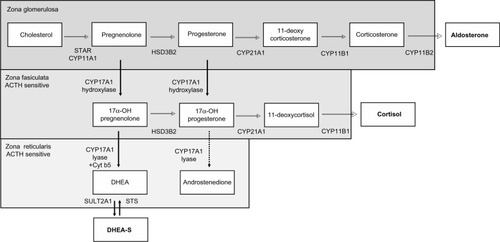Figures & data
Figure 1 Steroid hormone pathways in zones of the adrenal gland. Steroid synthesis in the adrenal gland occurs in three zones, each with a specific complement of enzymes that determine the steroids produced. The zona glomerulosa contains the enzymes necessary to produce aldosterone. The zona fasciculata and reticularis additionally express CYP17A. The hydroxylase activity of CYP17A is active in the zona fasciculata resulting in the production of cortisol. However, the lyase activity of CYP17A requires the cytochrome b5 coregulator which is only present in the zona reticularis. This drives efficient production of DHEA which is then sulfated to DHEA-S. 17α-OH progesterone is a relatively poor substrate for CYP17A lyase (dotted arrow), and thus androstenedione is formed at lower levels. The zona fasciculata and zona reticularis are sensitive to the ACTH feedback stimulation that occurs when cortisol production is suppressed by inhibition of CYP17A.
Abbreviations: 17α-OH, 17α-hydroxy; ACTH, adrenocorticotropic hormone; CYP11A, cytochrome P450 11α-hydroxylase; CYP11B, cytochrome P450 11β-hydroxylase; CYP17A, 17α-hydroxylase/17,20 lyase/17,20 desmolase; CYP21A, cytochrome P450 21α-hydroxylase; Cyt b5, cytochrome b5; DHEA, dehydroepiandrosterone; DHEA-S, dehydroepiandrosterone-sulfate; HSD3B, 3-β-hydroxysteroid dehydrogenase; STAR, steroidogenic acute regulatory protein.

